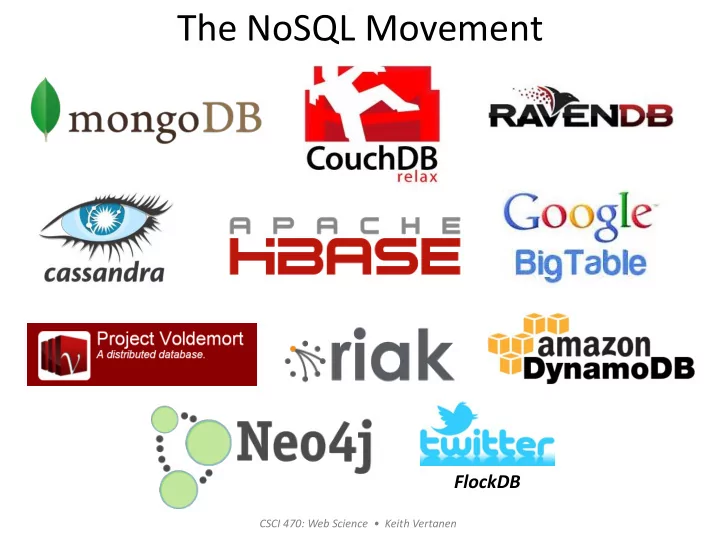

The NoSQL Movement FlockDB CSCI 470: Web Science • Keith Vertanen
2
3
http://techcrunch.com/2012/10/27/big-data-right-now-five-trendy-open-source-technologies/ 4
http://blog.beany.co.kr/archives/275 5
What's in a name? • #nosql • NoSQL: – Never SQL? – Not SQL? – No to SQL http://geekandpoke.typepad.com/geekan dpoke/2011/01/nosql.html 6
The revolution will be polygamous • Polygot programming, Neal Ford, 2006 – "It's all about choosing the right tool for the job and leveraging it correctly...The times of writing an application in a single general purpose language is over." • Polygot persistence, Martin Fowler, 2011 – "any decent sized enterprise will have a variety of different data storage technologies for different kinds of data. There will still be large amounts of it managed in relational stores, but increasingly we'll be first asking how we want to manipulate the data and only then figuring out what technology is the best bet for it." http://martinfowler.com/bliki/Poly glotPersistence.html 7
What defines it? • NoSQL characteristics: – Non-relational – Schema-less • Store whatever structure you like • Change it when you want – Cluster friendly • Parallelizable on clusters of commodity hardware • Enable web apps at massive scale – Open source (typically) – Variety of types / data models • No standard like with SQL 8
NoSQL advantages Horizontal scalability Big data Cheaper Availability 9
NoSQL advantages Goodbye highly- trained DBAs https://www.youtube.com/watch?v=oz-7wJJ9HZ0 Easier development: malleable models storing aggregates 10
NoSQL disadvantages • Maturity – Don't have 20 years of experience as with relational DBs • Support – Open source • Analytics, business intelligence – Ad hoc queries require programming • Administration – Takes skill to install and maintain (new form of DBAs?) • Developer expertise – RDBMS expertise is standard with developers – Developers still learning NoSQL – Less consistent: many different data models and variants 11
How is data structured? Key-value Document Column Graph FlockDB 12
Key-value 1042 1043 1001 1086 Value Key Opaque to DB: could be number, document, image, … A hash map that persists to disk 13
Document {"id" : 1001, "cust-id" : 9584, "line-items" : [ {"product-id": 5489, "quantity": 1}, {"product-id": 5948, "quantity": 12} ] } {"id" : 1002, "cust-id" : 96586, "line-items" : [ {"product-id": 8965, "quantity": 2, "color": "Red"} ], "last-order" : "2014-01-03" } No explicit schema 14
1042 "cust-id": 5424 1043 1001 1086 "cust-id": 9584 {"id" : 1001, "cust-id" : 9584, "line-items" : [ {"product-id": 5489, "quantity": 1}, {"product-id": 5948, "quantity": 12} ] } 15
Aggregates vs. RDMS http://martinfowler.com/bliki/AggregateOrientedDatabase.html 16
Aggregates vs. NoSQL "works really well when data access is aligned with the aggregates, but what if you want to look at the data in a different way? Order entry naturally stores orders as aggregates, but analyzing product sales cuts across the aggregate structure." -Martin Fowler 17
Aggregated-oriented DB: good for clusters 18
Changing architecture Customers Customers Billing Integration database Inventory Billing Inventory 19
Changing computation map map reduce map map map map map reduce reduce map map map map map reduce map map map 20
Map reduce: programming model • Input and output: set of key/value pairs • Need to specify two functions: map(in_key, in_value) → list(out_key, interm_value) – Processes input key/value pair – Produces set of intermediate pairs reduce(out_key, list(interm_value)) → list(out_value) – Combine intermediate values for a particular key – Produce a set of merged output values (usually one) 21
Map reduce: counting words map(String input_key, String input_value): // input_key: document name // input_value: document contents for each word w in input_value: EmitIntermediate(w, "1"); reduce(String output_key, Iterator intermediate_values): // output_key: a word // output_values: a list of counts int result = 0; for each v in intermediate_values: result += ParseInt(v); Emit(AsString(result)); 22 http://www.rabidgremlin.com/data20
Column "a spare, distributed, persistent, multi-dimensional, sorted map" http://research.google.com/archive/bigtable.html http://www.cs.rutgers.edu/~pxk/417/notes/content/bigtable.html 23
24
Graph FlockDB http://www.neo4j.org/training 25
Summary • Relational databases – Well understood, standard query language: SQL – Sprays logical unit across many tables • NoSQL – Aggregate-oriented, large cohesive chunks • Key-value • Document • Column – Graph database • Lots of small chunks with connections – Map-reduce • Compute efficiently maintaining good data locality 26
Recommend
More recommend